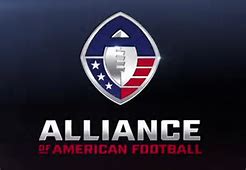Podcast: Play in new window | Download
Subscribe: RSS
When I read that the new Alliance of American Football (AAF) would attempt to complete their football games in no longer than 2 hours and 30 minutes (including overtime), I became quite interested.
In the weekend’s first set of games just one week after the NFL’s “Big Game”, my expectations were low for this latest attempt to provide fans with a professional alternative to the NFL. Most other attempts have failed, but this league has some potential and, more importantly, terrific timing.
With only eight teams in the new football league (Arizona Hotshots, Atlanta Legends, Birmingham Iron, Memphis Express, Orlando Apollos, Salt Lake Stallions, San Antonio Commanders, and San Diego Fleet), the league will play a ten game regular season schedule which ends with a championship game in Las Vegas on April 27.
There are several differences between the new AAF and many other failed professional football ventures attempted over the past 45 years. The deceased leagues included:
XFL – 2001
World League of American Football/NFL Europe – 1991 – 2007
USFL – 1983-1985
American Football Association – 1978-1983
World Football League – 1974-1975
First, the new AAF has the distinct advantage of great timing. In 2019, there are now several hungry cable sports television providers not named ESPN who are quite willing telecast the AAF’s initial season. The CBS Sports Network, NFL Network, and TNT will all telecast some of the games.
These cable competitors are quite aware that King Football’s viewership eclipses any other type of sports programming that they could provide viewers during the late winter/early spring period.
Next, the AAF seems to be quite content to be the “first or second chance into the NFL” league. More than 70% of the AAF rosters are filled with players who, at one point or another, have made an NFL team. There are a few familiar football players on nearly every AAF team.
Every player – from quarterback to kicker – in the AAF receives the same base salary and contract. Currently, it pays $250,000 for three seasons.
For some players, they may get their next NFL “chance” this summer, and, with it, a higher pay. For others, receiving $83,000 per year to play a ten-game season on national television isn’t the worst thing, either.
For the AAF, the pay scale makes player salaries a controllable cost of doing business. With a 52-man roster, that would equate to an annual player payroll of $4.33 million.
For a point of reference, that also means that it would take nearly six complete AAF teams to match the pay for the New Orleans Saints’ quarterback Drew Brees’ ($25 million) during the 2018 NFL season.
Isn’t capitalism great?
The AAF features a few nifty fan-friendly rule changes, too.
There are no kickoffs (the ball is placed at the 25 yard line), no kicked extra points (two-point conversions only), no television time-outs (YES!), and, in the event of overtime, each team will get the ball on the opponent’s ten yard line one time (with a two-point conversion). If the game remains tied after each team’s possession, the game ends in a tie as the league remains mindful of keeping playing time to no more than two hours and thirty minutes.
In week one, the attendance at the home openers were in the 20,000-25,000 range. There was enough home crowd noise so that television audience could easily tell which squad was playing at home.
For an opening weekend, the flow of the games (including referees, Saints fans) went smoothly. Fans at the stadium and viewers on television saw a very professional product.
The AAF doesn’t want to be the NFL, but you can definitely see the possibility of the league forming a more friendly association with the NFL as a permanent “developmental” league.
In contrast, the rebooted version of Vince McMahon’s XFL in 2020 seeks to take on the Goliath named the NFL. That’s another story for another time.
With lower expectations and good execution, the AAF passed the quality assurance test of most fans during week one. I recommend that you take the time to check it out, too.
This new football league is to be taken seriously for now.
I’ll give the AAF a solid “B” for the opening weekend as the league delivered what it promised.

